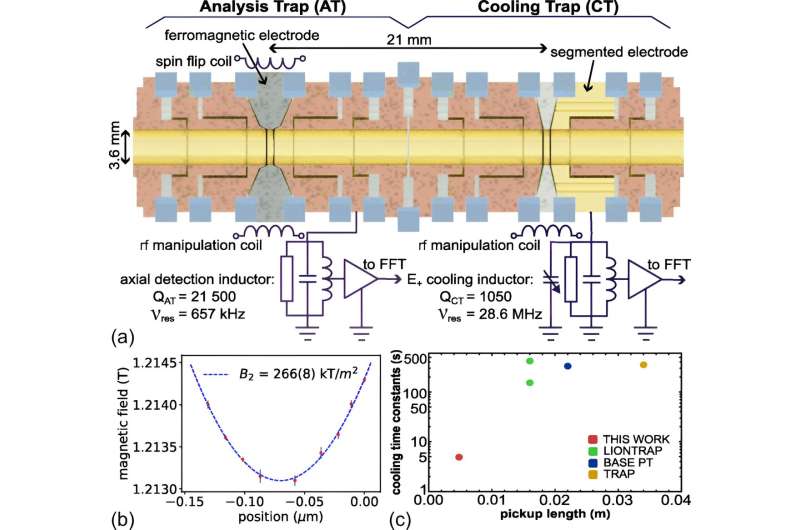
Why does the universe contain matter and (virtually) no antimatter? The BASE international research collaboration at the European Organization for Nuclear Research (CERN) in Geneva, headed by Professor Dr. Stefan Ulmer from Heinrich Heine University Düsseldorf (HHU), has achieved an experimental breakthrough in this context.
It can contribute to measuring the mass and magnetic moment of antiprotons more precisely than ever before—and thus identify possible matter-antimatter asymmetries. BASE has developed a trap, which can cool individual antiprotons much more rapidly than in the past, as the researchers explain in Physical Review Letters.
After the Big Bang more than 13 billion years ago, the universe was full of high-energy radiation, which constantly generated pairs of matter and antimatter particles such as protons and antiprotons.
When such a pair collides, the particles are annihilated and converted into pure energy again. So, all in all, exactly the same quantities of matter and antimatter should be generated and annihilated again, meaning that the universe should be largely matterless as a consequence.
However, there is clearly an imbalance—an asymmetry—as material objects do exist. A minuscule amount more matter than antimatter has been generated—which contradicts the standard model of particle physics. Physicists have therefore been seeking to expand the standard model for decades. To this end, they also need extremely precise measurements of fundamental physical parameters.
This is the starting point for the BASE collaboration (“Baryon Antibaryon Symmetry Experiment”). It involves the universities in Düsseldorf, Hanover, Heidelberg, Mainz and Tokyo, the Swiss Federal Institute of Technology in Zurich and the research facilities at CERN in Geneva, the GSI Helmholtz Center in Darmstadt, the Max Planck Institute for Nuclear Physics in Heidelberg, the National Metrology Institute of Germany (PTB) in Braunschweig and RIKEN in Wako/Japan.
“The central question we are seeking to answer is: Do matter particles and their corresponding antimatter particles weigh exactly the same and do they have exactly the same magnetic moments, or are there minuscule differences?” explains Professor Stefan Ulmer, spokesperson for BASE. He is a professor at the Institute for Experimental Physics at HHU and also conducts research at CERN and RIKEN.
The physicists want to take extremely high resolution measurements of the so-called spin-flip—quantum transitions of the proton spin—for individual, ultra-cold and thus extremely low-energy antiprotons; i.e. the change in orientation of the spin of the proton.
“From the measured transition frequencies, we can, among other things, determine the magnetic moment of the antiprotons—their minute internal bar magnets, so to speak,” explains Ulmer. Adding, “The aim is to see with an unprecedented level of accuracy whether these bar magnets in protons and antiprotons have the same strength.”
Preparing individual antiprotons for the measurements in a way that enables such levels of accuracy to be achieved is an extremely time-consuming experimental task. The BASE collaboration has now taken a decisive step forward in this regard.
Dr. Barbara Maria Latacz from CERN and lead author of the study says, “We need antiprotons with a maximum temperature of 200 mK, i.e. extremely cold particles. This is the only way to differentiate between various spin quantum states. With previous techniques, it took 15 hours to cool antiprotons, which we obtain from the CERN accelerator complex, to this temperature. Our new cooling method shortens this period to eight minutes.”
The researchers achieved this by combining two so-called Penning traps into a single device, a “Maxwell’s daemon cooling double trap.” This trap makes it possible to prepare solely the coldest antiprotons on a targeted basis and use them for the subsequent spin-flip measurement; warmer particles are rejected. This eliminates the time needed to cool the warmer antiprotons.
The significantly shorter cooling time is needed to obtain the required measurement statistics in a significantly shorter period of time so that measuring uncertainties can be reduced further.
Latacz says, “We need at least 1,000 individual measurement cycles. With our new trap, we need a measurement time of around one month for this—compared with almost ten years using the old technique, which would be impossible to realize experimentally.”
Ulmer: “With the BASE trap, we have already been able to measure that the magnetic moments of protons and antiprotons differ by max. one billionth—we are talking about 10-9. We have been able to improve the error rate of the spin identification by more than a factor of 1,000. In the next measurement campaign, we are hoping to improve magnetic moment accuracy to 10-10.”
Professor Ulmer said, “We want to construct a mobile particle trap, which we can use to transport antiprotons generated at CERN in Geneva to a new laboratory at HHU. This is set up in such a way that we can hope to improve the accuracy of measurements by at least a further factor of 10.”
Traps for fundamental particles
Traps can store individual electrically charged fundamental particles, their antiparticles or even atomic nuclei for long periods of time using magnetic and electric fields. Storage periods of over ten years are possible. Targeted particle measurements can then be made in the traps.
There are two basic types of construction: So-called Paul traps (developed by the German physicist Wolfgang Paul in the 1950s) use alternating electric fields to hold particles. The “Penning traps” developed by Hans G. Dehmelt use a homogeneous magnetic field and an electrostatic quadrupole field. Both physicists received the Nobel Prize for their developments in 1989.
More information:
B. M. Latacz et al, Orders of Magnitude Improved Cyclotron-Mode Cooling for Nondestructive Spin Quantum Transition Spectroscopy with Single Trapped Antiprotons, Physical Review Letters (2024). DOI: 10.1103/PhysRevLett.133.053201
Provided by
Heinrich-Heine University Duesseldorf
Citation:
Cold antimatter for quantum state-resolved precision measurements (2024, August 2)
retrieved 2 August 2024
from https://phys.org/news/2024-08-cold-antimatter-quantum-state-precision.html
This document is subject to copyright. Apart from any fair dealing for the purpose of private study or research, no
part may be reproduced without the written permission. The content is provided for information purposes only.
